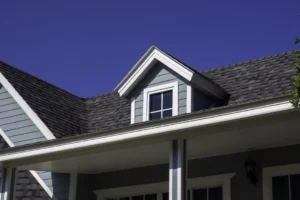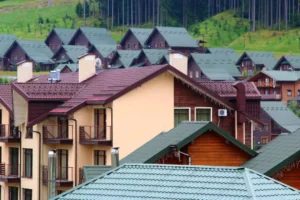As a developer or owner of multi-family housing properties, you know how important it is to optimize your return on investment and reduce your operating costs. One of the key factors that affect your bottom line is the energy efficiency of your buildings, especially the roofing system.
Roofing is not only the first line of defense against the elements but also a major contributor to the thermal performance and comfort of your units. A poorly designed or maintained roof can lead to excessive heat loss or gain, moisture problems, air leaks, and higher energy bills.
That’s why at Dimensional Pro, we offer professional roofing services that can help you improve the efficiency and durability of your multi-family housing roofs. We have over 10 years of experience in the roofing industry, and we use the latest materials and techniques to ensure quality results.
In this blog post, we will share some of the best practices and tips for maximizing roofing efficiency in multi-family housing, based on our expertise and research. Whether you are planning a new construction project or a retrofit of an existing building, these ideas can help you achieve your goals and save money in the long run.
Choose the Right Roofing Material
The type of roofing material you choose can have a significant impact on the energy efficiency of your building. Different materials have different properties, such as reflectivity, emissivity, insulation value, and durability. Depending on your climate and design preferences, you may want to consider the following options:
- Metal roofing: Metal roofs are highly reflective and emissive, meaning they can reflect most of the solar radiation and release most of the absorbed heat back to the atmosphere. This can reduce the cooling load and the urban heat island effect. Metal roofs are also durable, lightweight, and fire-resistant. However, they can be noisy during rain or hail, and they may require additional insulation to prevent heat loss in cold climates.
- Asphalt shingles: Asphalt shingles are the most common and affordable roofing material in the U.S. They come in a variety of colors and styles, and they can last up to 20 years with proper maintenance. However, asphalt shingles are not very energy efficient, as they tend to absorb a lot of solar radiation and transfer heat to the building. They are also prone to cracking, curling, and fading over time. To improve their efficiency, you may want to opt for cool or solar-reflective shingles, which have a higher reflectivity and emissivity than standard shingles.
- Tile roofing: Tile roofs are popular in warm and sunny climates, as they can provide a natural ventilation and cooling effect. Tile roofs are made of clay, concrete, or slate, and they have a high thermal mass, meaning they can store heat during the day and release it at night. Tile roofs are also durable, fire-resistant, and aesthetically pleasing. However, they are heavy, expensive, and fragile, and they may require additional structural support and maintenance.
- Green roofing: Green roofs are roofs that are partially or fully covered with vegetation, such as grass, flowers, or herbs. Green roofs can provide multiple benefits, such as reducing stormwater runoff, improving air quality, enhancing biodiversity, and creating recreational spaces. Green roofs can also improve the energy efficiency of your building, as they can provide insulation, shade, and evaporative cooling. However, green roofs are complex and costly to install and maintain, and they may require special permits and regulations.
Optimize the Roof Design and Layout
The shape and layout of your roof can also affect its energy efficiency. Depending on your building’s orientation, size, and style, you may want to consider the following aspects:
- Roof slope: The slope or pitch of your roof determines how much solar radiation it receives and how well it sheds water and snow. A low-sloped or flat roof can reduce the exposure to direct sunlight and lower the cooling load, but it can also accumulate water and debris, leading to leaks and mold. A high-sloped or steep roof can enhance the drainage and ventilation of your roof, but it can also increase the surface area and the heating load. The optimal roof slope depends on your climate and roofing material, but generally, it should be between 15 and 45 degrees.
- Roof color: The color of your roof can influence its reflectivity and emissivity, which are the key factors for reducing the heat gain and loss of your building. A light-colored or white roof can reflect most of the solar radiation and keep your roof cool, while a dark-colored or black roof can absorb most of the solar radiation and heat up your roof. The ideal roof color depends on your climate and roofing material, but generally, you should choose a lighter color for hot and sunny climates and a darker color for cold and cloudy climates.
- Roof insulation: The insulation of your roof can prevent the heat transfer between your building and the outside environment, improving the thermal comfort and efficiency of your units. The amount and type of insulation you need depends on your climate and roofing material, but generally, you should aim for a high R-value, which is the measure of the insulation’s resistance to heat flow. The recommended R-value for roofs ranges from R-30 to R-60, depending on your climate zone. You can use different types of insulation materials, such as fiberglass, cellulose, foam, or mineral wool, and you can install them either above or below the roof deck, depending on your roof design and ventilation.
Maintain and Repair Your Roof Regularly
The condition and performance of your roof can deteriorate over time, due to factors such as weather, wear and tear, and aging. To ensure the efficiency and durability of your roof, you should inspect and maintain it regularly, and repair any damages or issues as soon as possible. Some of the common signs and causes of roof problems include:
- Leaks and water damage: Leaks and water damage can occur due to cracks, holes, or gaps in your roof, or due to improper flashing, drainage, or ventilation. Leaks and water damage can lead to mold, rot, corrosion, and structural damage, as well as increased humidity and energy consumption. To prevent and fix leaks and water damage, you should seal and caulk any openings, replace any missing or damaged shingles or tiles, clean and unclog your gutters and downspouts, and ensure adequate ventilation and insulation of your roof.
- Blistering and peeling: Blistering and peeling can occur due to excessive heat, moisture, or pressure on your roof, or due to poor installation or quality of your roofing material. Blistering and peeling can reduce the reflectivity and emissivity of your roof, as well as its aesthetic appeal and lifespan. To prevent and fix blistering and peeling, you should avoid walking or placing heavy objects on your roof, use high-quality and compatible roofing materials, and apply a protective coating or paint on your roof.
- Sagging and buckling: Sagging and buckling can occur due to excessive weight, moisture, or movement on your roof, or inadequate structural support or design of your roof. Sagging and buckling can compromise the integrity and stability of your roof, as well as its drainage and ventilation. To prevent and fix sagging and buckling, you should remove any excess snow, ice, or debris from your roof, ensure proper alignment and spacing of your roof rafters and trusses, and reinforce or replace any weak or damaged sections of your roof.
Hire a Professional Roofing Contractor
One of the best ways to maximize the roofing efficiency in your multi-family housing is to hire a professional roofing contractor who can provide you with expert advice, quality workmanship, and exceptional customer service. A professional roofing contractor can help you choose the right roofing material, design, and layout for your project, as well as install, maintain, and repair your roof according to industry standards and best practices.
At Dimensional Pro, we are more than just painters. We are also experienced and licensed roofing contractors who can handle any roofing project, big or small. We have the skills, tools, and resources to deliver outstanding results that meet your expectations and budget. We also offer a 5-year warranty on our roofing services, as well as free estimates and consultations.
If you are looking for a reliable and reputable roofing contractor for your multi-family housing project, look no further than Dimensional Pro. Contact us today to find out how we can help you improve the efficiency and value of your property. We look forward to hearing from you and working with you.








